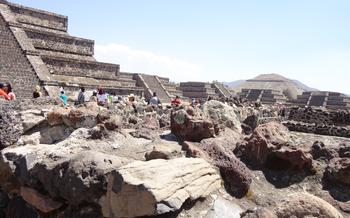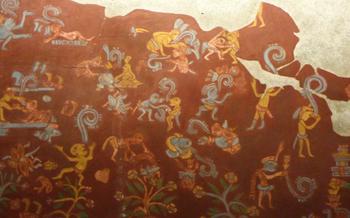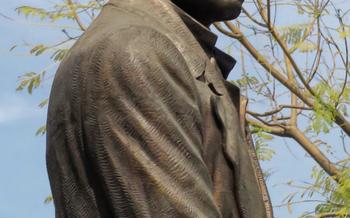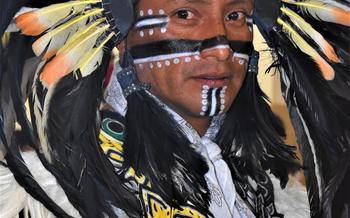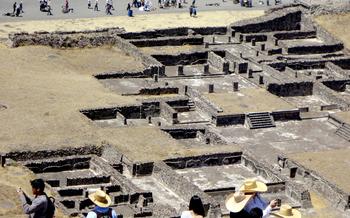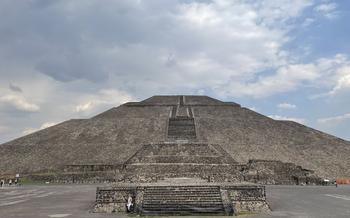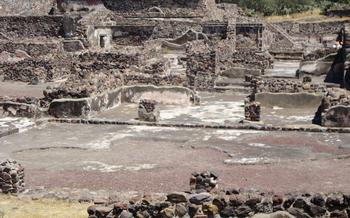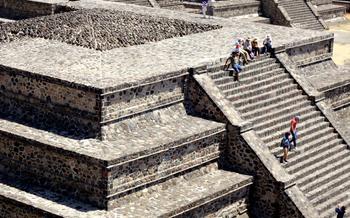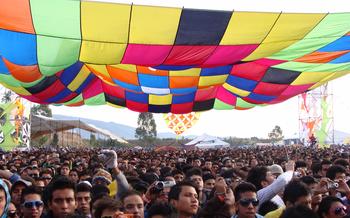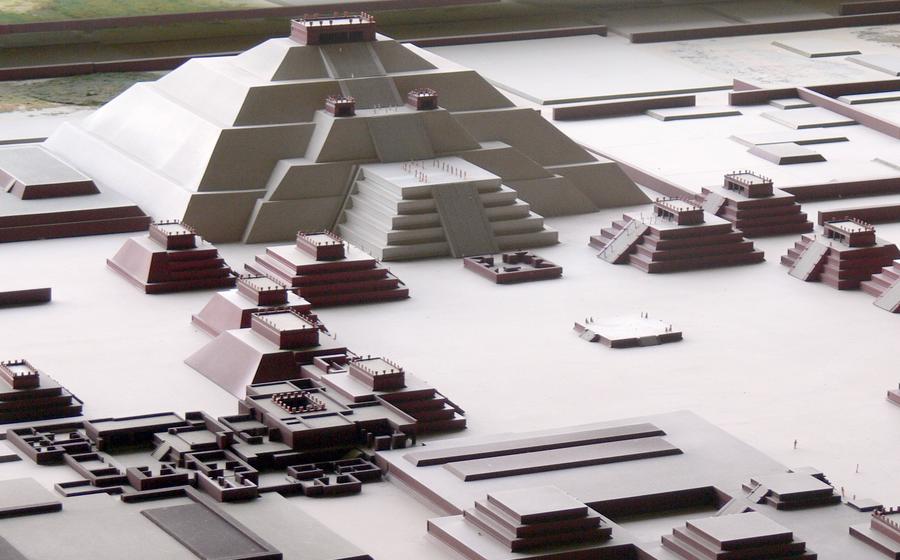
Teotihuacan Museum (Museo de la Sitio)
- A Journey Through Ancient Civilizations
- Unveiling the mysteries of the Pyramids
- Exploring the Avenue of the Dead
- Murals and Paintings: Windows to the Past
- Other Notable Structures
- Temple of Quetzalcoatl
- Temple of the Feathered Shells
- Tetitla Compound
- Artifacts and Excavations
- Teotihuacan Museum
- Planning Your Visit
- A Walk Through History
- The Enigmatic Collapse
- Beyond Teotihuacan: Enriching Your Mexican Experience
- Cultural Insights
- Local Delicacies
- Insider Tip: Unveiling Hidden Gems
A Journey Through Ancient Civilizations
Teotihuacan, a name that evokes images of ancient grandeur, is a city frozen in time, preserving the legacy of one of Mesoamerica's most enigmatic civilizations. Situated just northeast of Mexico City, Teotihuacan flourished between the 1st and 7th centuries AD, leaving behind a testament to its architectural prowess, cultural achievements, and religious significance.
The city's origins remain shrouded in mystery, with various theories suggesting its establishment by indigenous groups or migrants from other Mesoamerican regions. As Teotihuacan grew, it became a major religious and cultural center, drawing pilgrims and traders from across the region. Its influence extended far beyond its physical boundaries, shaping the cultural and religious landscape of Mesoamerica.
Teotihuacan's legacy extends beyond its physical remains. Its artistic expressions, technological innovations, and religious practices have left an indelible mark on Mexican culture, influencing subsequent civilizations such as the Aztecs. Exploring Teotihuacan is not just a journey through ancient ruins but a voyage into the heart of Mesoamerican history, unraveling the mysteries of a civilization that continues to captivate and inspire.
Unveiling the mysteries of the Pyramids
The towering Pyramid of the Sun and the Pyramid of the Moon stand as testaments to the architectural prowess of the Teotihuacan civilization. The Pyramid of the Sun, the largest structure in the city, is a marvel of engineering, rising over 216 feet (66 meters) in height. Its precise alignment with the celestial bodies during equinoxes and solstices suggests a profound understanding of astronomy.
The Pyramid of the Moon, though slightly smaller, boasts a unique feature—a cave located beneath its structure. This cave, known as the Cave of the Moon, was likely used for religious rituals and ceremonies. Theories abound regarding the construction of these pyramids. Some suggest they were built as tombs for rulers or as temples for religious worship. Others believe they served as astronomical observatories or even as symbols of power and prestige.
Beyond their physical grandeur, the pyramids are adorned with intricate carvings and symbols, adding to their enigmatic allure. These symbols, often depicting deities, celestial bodies, and mythological creatures, provide valuable insights into the beliefs and practices of the Teotihuacan people. The pyramids of Teotihuacan remain awe-inspiring monuments, embodying the ingenuity, artistry, and spiritual beliefs of one of Mesoamerica's most advanced civilizations.
Exploring the Avenue of the Dead
Stretching over 2 kilometers, the Avenue of the Dead, known in Nahuatl as Miccaotli, served as the central axis and main artery of the ancient city of Teotihuacan. This grand thoroughfare connected the Ciudadela in the north with the Temple of the Moon in the south, passing through significant structures and plazas along its path.
The Avenue of the Dead boasts a symmetrical layout, with platforms, temples, and residential compounds arranged on either side. The most prominent structures include the Pyramid of the Sun, the Pyramid of the Moon, the Temple of Quetzalcoatl, and the Ciudadela. These monumental edifices, with their imposing presence, add to the grandeur and significance of the avenue.
The Avenue of the Dead played a crucial role in religious processions, ceremonies, and public gatherings. During festivals and rituals, the avenue would have been bustling with activity as people gathered to celebrate, pay homage to their deities, and participate in community events. This vibrant thoroughfare served as a stage for the unfolding of Teotihuacan's rich cultural and religious life.
Murals and Paintings: Windows to the Past
Teotihuacan's rich artistic heritage is vividly displayed in the numerous murals and paintings found throughout the city. These artworks, often vibrant and intricate, offer a glimpse into the beliefs, rituals, and daily lives of the Teotihuacan people. The murals depict a variety of subjects, including mythological scenes, historical events, and representations of nature. The most famous murals can be found in the Temple of Quetzalcoatl, where brightly colored serpents and feathered figures adorn the walls. The paintings, on the other hand, are smaller in scale and were likely used to decorate the interiors of buildings.
The symbolism and meanings behind these artworks are still debated by scholars. Some believe that the murals and paintings served as a form of religious propaganda, promoting the cult of the feathered serpent god, Quetzalcoatl. Others suggest that they were intended to commemorate important historical events or to educate the population about the city's history and mythology. Regardless of their purpose, these artworks provide valuable insights into the mindset and worldview of the Teotihuacan civilization.
The techniques and materials used in creating these artworks are also noteworthy. The murals were typically painted on a layer of stucco, which was then covered with a thin layer of plaster. The pigments used were derived from natural sources, such as minerals, plants, and insects. The paintings were usually executed on a smaller scale, using a variety of brushes and tools. The artists demonstrated a remarkable level of skill and precision, creating detailed and lifelike representations of their subjects.
These murals and paintings are not only beautiful works of art but also invaluable sources of information about the Teotihuacan civilization. They offer a glimpse into the religious beliefs, cultural practices, and artistic traditions of this ancient society, providing a deeper understanding of their complex and fascinating world.
Other Notable Structures
Beyond the iconic pyramids, Teotihuacan boasts a wealth of other captivating structures that offer unique insights into the ancient city's grandeur and complexity.
Temple of Quetzalcoatl
Dedicated to the feathered serpent god Quetzalcoatl, this temple is renowned for its vibrant murals depicting the deity's transformative journey. The intricate artwork showcases the artistic prowess of Teotihuacan's artisans and provides valuable clues about religious beliefs and mythology.
Temple of the Feathered Shells
Located near the Pyramid of the Moon, this temple is adorned with exquisite carvings of conch shells, a symbol of fertility and abundance. Its well-preserved murals depict scenes of human sacrifice and ritual ceremonies, offering a glimpse into the sacred practices of Teotihuacan's inhabitants.
Tetitla Compound
This residential complex, once home to elite Teotihuacan families, offers a fascinating glimpse into the daily lives of the city's upper classes. Excavations have revealed beautifully painted murals, elaborate courtyards, and intricate drainage systems, providing valuable insights into the domestic architecture and lifestyle of Teotihuacan's elite.
Artifacts and Excavations
Teotihuacan has yielded a treasure trove of archaeological findings, providing invaluable insights into the city's past. Excavations have unearthed an array of artifacts, including intricate sculptures, ceramic vessels, obsidian tools, and precious ornaments. These artifacts shed light on the daily lives, beliefs, and artistic expressions of the Teotihuacan people.
One of the most significant discoveries was the Green Goddess statue, a mesmerizing sculpture carved from greenstone, symbolizing fertility and abundance. Another notable find was the Teotihuacan Death Mask, adorned with turquoise, jade, and pyrite, representing the transition into the afterlife.
Ongoing excavations continue to unveil new secrets about Teotihuacan. Recent discoveries include a massive underground tunnel beneath the Pyramid of the Sun, believed to have been used for rituals or as a burial chamber. These ongoing investigations are crucial in unraveling the mysteries of this ancient civilization and deepening our understanding of their remarkable legacy.
Teotihuacan Museum
The Teotihuacan Museum, also known as the Museo de la Sitio, stands as a testament to the rich history and cultural legacy of the ancient Teotihuacan civilization. Situated adjacent to the archaeological site, this museum serves as a treasure trove of artifacts, replicas, and exhibits that provide visitors with an immersive experience into the city's past.
Divided into several sections, the museum offers a comprehensive journey through the various aspects of Teotihuacan's culture and daily life. The exhibits showcase a vast collection of ceramic vessels, stone sculptures, jewelry, and other artifacts unearthed during excavations at the site. These artifacts offer valuable insights into the artistic prowess, technological advancements, and belief systems of the Teotihuacan people.
Among the highlights of the museum's collection are the impressive replicas of the Teotihuacan murals. These vibrant and intricate artworks, originally adorning the walls of temples and palaces, depict scenes from mythology, religious rituals, and everyday life. The replicas provide visitors with a glimpse into the rich visual language and storytelling traditions of the ancient city.
The Teotihuacan Museum plays a crucial role in preserving, showcasing, and interpreting the cultural heritage of this ancient metropolis. Through its exhibits and educational programs, the museum contributes to the ongoing exploration and understanding of one of Mesoamerica's most enigmatic and influential civilizations.
Planning Your Visit
Timing is crucial for an enriching experience at Teotihuacan. The best time to visit is during the shoulder months (April-May and September-October) when the weather is pleasant, and crowds are manageable. Aim to arrive early in the morning to avoid the midday heat and soak in the tranquility of the site.
To navigate the vast archaeological zone, comfortable shoes are a must. The Avenue of the Dead is relatively flat, but exploring the pyramids and other structures involves climbing steep steps. Sunscreen, sunglasses, and a hat are essential to shield yourself from the intense sun. Bring plenty of water, as there are limited refreshment options within the site.
Don't forget your camera to capture the awe-inspiring monuments and the panoramic views. Tripods are permitted, but drones are not allowed for safety reasons. To delve deeper into the history and significance of Teotihuacan, consider hiring a knowledgeable guide. Guided tours are available in various languages, providing insights that enhance your understanding of this ancient city.
A Walk Through History
Exploring Teotihuacan on foot is an immersive experience that allows you to connect with the ancient city's grandeur. Guided tours are available for those who prefer a comprehensive understanding of the site's history and significance. These tours often provide insights into the construction techniques, religious beliefs, and daily life of the Teotihuacan people.
For those who prefer self-guided exploration, maps and guidebooks are available at the entrance of the archaeological park. Recommended routes take visitors through the main highlights of the site, including the Avenue of the Dead, the Pyramid of the Sun, and the Pyramid of the Moon.
Photography enthusiasts will find ample opportunities to capture stunning images of the pyramids, murals, and sculptures. The best time for photography is early in the morning or late in the afternoon when the light is soft and golden.
The Enigmatic Collapse
Even as Teotihuacan flourished, the seeds of its downfall were being sown. Around the 7th century AD, the once-mighty city began to decline, eventually leading to its abandonment. The reasons for this collapse are still debated among scholars.
Some theories point to environmental factors, such as prolonged drought or climate change, which may have led to crop failures and food shortages. Others suggest internal conflicts or invasions from rival powers weakened the city, making it vulnerable to external threats.
One intriguing theory proposes that a widespread rebellion or uprising within the city's population contributed to its demise. This hypothesis is supported by evidence of widespread burning and destruction found at the site, indicating a violent end to Teotihuacan's reign.
Ongoing research and excavations continue to shed light on the mysteries surrounding Teotihuacan's fall. By piecing together archaeological evidence and historical accounts, researchers hope to unravel the secrets of the city's decline and gain a deeper understanding of the factors that brought about its end.
Beyond Teotihuacan: Enriching Your Mexican Experience
While Teotihuacan stands as the crown jewel of ancient Mexican history, venturing beyond its borders unveils an array of additional treasures. Explore the nearby city of San Juan Teotihuacan, where vibrant markets offer a kaleidoscope of local crafts, textiles, and delectable street food. For a unique cultural immersion, visit the Museo del Pulque, dedicated to the history and production of pulque, a traditional Mexican alcoholic beverage made from fermented maguey sap.
Combine your exploration of Teotihuacan with a visit to the Basilica of Our Lady of Guadalupe, a sacred pilgrimage site for Catholics worldwide. This awe-inspiring basilica houses the tilma of Juan Diego, on which the image of the Virgin Mary is said to have miraculously appeared.
Extend your journey to the enchanting colonial cities of Puebla and Tlaxcala, renowned for their colorful architecture, rich culinary traditions, and vibrant festivals. Immerse yourself in the beauty of Puebla's historic center, a UNESCO World Heritage Site, and savor the flavors of its world-famous mole poblano. In Tlaxcala, discover the murals of Diego Rivera and José Clemente Orozco, which depict the history and culture of Mexico.
For an adventurous escape, venture into the mystical landscapes of the Sierra de las Cruces, a mountain range located just east of Teotihuacan. Hike through lush forests, encounter hidden waterfalls, and revel in the breathtaking views of the surrounding valleys. The Sierra de las Cruces also offers opportunities for camping, mountain biking, and rock climbing.
Cultural Insights
To truly understand Teotihuacan, one must delve into the symbolism and beliefs of its people. The Teotihuacanos held a deep reverence for nature, as evidenced by the many depictions of animals, plants, and celestial bodies in their art and architecture. They believed in a complex pantheon of gods, including the rain god Tlaloc, the fire god Huehueteotl, and the feathered serpent Quetzalcoatl. These deities were seen as intermediaries between the natural and spiritual worlds, and they played a crucial role in the daily lives of the Teotihuacanos.
The city's layout and orientation also reflect its spiritual significance. The Avenue of the Dead, which runs north-south, was believed to be a sacred path connecting the earthly world with the realm of the gods. The Pyramid of the Sun, the largest structure in the city, was aligned with the rising sun on the summer solstice, suggesting a connection between the city and the solar calendar.
The legacy of Teotihuacan continues to shape Mexican culture today. The city's pyramids, murals, and artifacts are a source of national pride, and they continue to inspire artists, writers, and musicians. The ancient city's spiritual beliefs have also left a lasting impact on Mexican culture. The veneration of nature, the belief in a complex pantheon of gods, and the concept of a sacred path connecting the earthly and spiritual worlds are all still evident in Mexican culture today.
Local Delicacies
Exploring Teotihuacan offers a unique opportunity to savor the vibrant flavors of Mexican cuisine. As you wander through the ancient city, tantalizing aromas waft from local eateries, inviting you to indulge in culinary delights. From traditional dishes to modern interpretations, the surrounding area boasts a diverse culinary scene that will satisfy every palate.
For an authentic taste of Mexican cuisine, visit one of the many traditional restaurants or food stalls near Teotihuacan. Sample the mouthwatering barbacoa, a slow-cooked lamb or goat dish that melts in your mouth. Pair it with a refreshing pulque, a fermented beverage made from the sap of the maguey plant. If you prefer something lighter, opt for a plate of freshly made quesadillas, filled with cheese, vegetables, or your choice of meat.
Don't miss out on the opportunity to try escamoles, a delicacy made from ant eggs, sautéed with butter and herbs. This unique dish offers a nutty, earthy flavor that will surprise and delight your taste buds. For a sweet treat, indulge in a slice of pan de muerto, a traditional bread decorated with sugar skulls, a symbol of the Day of the Dead celebrations.
Throughout your culinary journey, embrace the vibrant colors, textures, and flavors that define Mexican cuisine. Whether you choose to dine at a traditional restaurant or savor street food from local vendors, each bite will offer a taste of Mexico's rich culinary heritage.
Insider Tip: Unveiling Hidden Gems
Unleash your inner explorer and venture beyond the main attractions to discover hidden gems within Teotihuacan. For a breathtaking panorama, ascend the Cerro Gordo, a hill located west of the Pyramid of the Sun. From this vantage point, you'll be rewarded with an unparalleled vista of the entire archaeological site, capturing the majesty of the pyramids against the backdrop of the surrounding landscape.
To escape the tourist throngs and immerse yourself in the tranquility of this ancient city, plan your visit during the early morning hours or on weekdays. This serene ambiance allows you to fully appreciate the grandeur of Teotihuacan without the distractions of large crowds.
Keen-eyed visitors may stumble upon unusual or hidden features within the archaeological site. Look for the intricate carvings adorning the walls of the Temple of Quetzalcoatl, depicting mythical creatures and deities. Discover the enigmatic "talking heads" embedded in the facade of the Temple of the Feathered Shells, each with a unique expression that seems to whisper secrets from the past.
